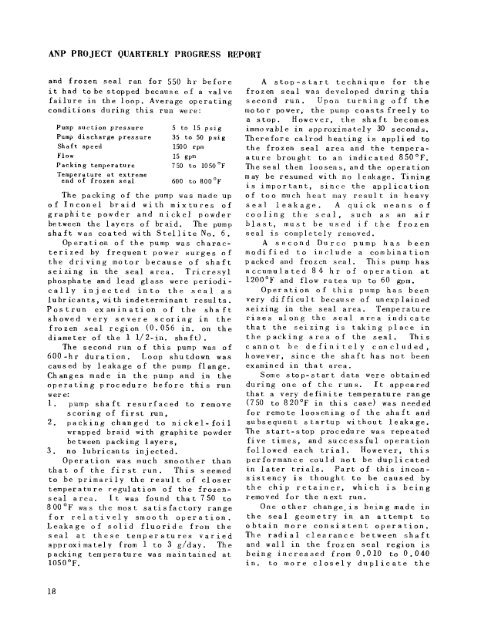the Molten Salt Energy Technologies Web Site
the Molten Salt Energy Technologies Web Site
the Molten Salt Energy Technologies Web Site
Create successful ePaper yourself
Turn your PDF publications into a flip-book with our unique Google optimized e-Paper software.
ANP PROJECT QUARTERLY PROGRESS REPORT<br />
and frozen seal ran for 550 hr before<br />
it had to be stopped because of a valve<br />
failure in <strong>the</strong> loop. Average operating<br />
conditions during t,his run were:<br />
Pump suction pressure 5 to 15 psig<br />
Pump discharge pressure 35 to 50 psig<br />
Shaft speed 1500 rpm<br />
Flow 15 gpm<br />
Packing temperature 750 to 1050OF<br />
Temperature at extreme<br />
end of frozen seal 600 to 800°F<br />
The packing of <strong>the</strong> pump was made up<br />
of Inconel braid with mixtures of<br />
graphite powder and nickel powder<br />
bet,ween <strong>the</strong> layers of braid. The pump<br />
shaft was coated with Stellite No. 6.<br />
Operation of <strong>the</strong> pump was charac-<br />
terized by frequent power surges of<br />
<strong>the</strong> driving motor because of shaft<br />
seizing in <strong>the</strong> seal area. Tricresyl<br />
phosphate and lead glass were periodi-<br />
cally injected into <strong>the</strong> seal as<br />
lubricants, with indeterminant results.<br />
Postrun examination of <strong>the</strong> shaft<br />
showed very severe scoring in <strong>the</strong><br />
frozen seal region (0.056 in. on <strong>the</strong><br />
diameter of <strong>the</strong> 1 1/2-in. shaft).<br />
The second run of this pump was of<br />
600 -hr duration. Loop shutdown was<br />
caused by leakage of <strong>the</strong> pump flange.<br />
Changes made in <strong>the</strong> pump and in <strong>the</strong><br />
operating procedure before this run<br />
were:<br />
1. pump shaft resurfaced to remove<br />
scoring of first run,<br />
2. packing changed to nickel-foil<br />
wrapped braid with graphite powder<br />
be tween packing 1 ayer s,<br />
3. no lubricants injected.<br />
Operation was much smoo<strong>the</strong>r than<br />
that of <strong>the</strong> first run. This seemed<br />
to be primarily <strong>the</strong> result of closer<br />
temperature regulation of <strong>the</strong> frozen-<br />
seal area. It was found that 750 to<br />
800°F was <strong>the</strong> most satisfactory range<br />
for relatively smooth operation.<br />
Leakage of solid fluoride from <strong>the</strong><br />
sen1 at <strong>the</strong>se temperatures varied<br />
approximately from 1 t o 3 g/day. The<br />
packing temperature was maintained at<br />
1050°F.<br />
18<br />
A stop-start technique for <strong>the</strong><br />
frozen seal was developed during this<br />
second run. Upon turning off <strong>the</strong><br />
iiiotor power, <strong>the</strong> pump coasts freely to<br />
a stop. However, <strong>the</strong> shaft becomes<br />
immovable in approximately 30 seconds.<br />
Therefore calrod heating is applied to<br />
<strong>the</strong> frozen seal area and <strong>the</strong> tempera-<br />
ature brought to an indicated 850°F.<br />
Theseal <strong>the</strong>n loosens, and <strong>the</strong> operation<br />
may be resumed with no leakage. Timing<br />
is important, since <strong>the</strong> application<br />
of too much heat may result in heavy<br />
seal leakage. A quick mean5 of<br />
cooling <strong>the</strong> seal, such as an air<br />
blast, must be used if <strong>the</strong> frozen<br />
seal is completely removed.<br />
A second Durco pump has been<br />
modified to include a combination<br />
packed and frozen seal. This pump has<br />
accumulated 84 hr of operation at<br />
1200°F and flow rates up to 60 gpm.<br />
Operation of this pump has been<br />
very difficult because of unexplained<br />
seizing in <strong>the</strong> seal area. Temperature<br />
rise5 along <strong>the</strong> seal area indicate<br />
that <strong>the</strong> seizing is taking place in<br />
<strong>the</strong> packing area of <strong>the</strong> seal. This<br />
cannot be definitely concluded,<br />
however, since <strong>the</strong> shaft has not been<br />
examined in that area.<br />
Some stop-start data were obtained<br />
during one of <strong>the</strong> runs. It appeared<br />
that a very definite temperature range<br />
(750 to 820°F in this case) was needed<br />
for remote loosening of <strong>the</strong> shaft and<br />
subsequent startup without leakage.<br />
The start-stop procedure was repeated<br />
five times, and successful operation<br />
followed each trial. However, this<br />
performance could not he duplicated<br />
in later trials. Part of this incon-<br />
sistency is thought to be caused by<br />
<strong>the</strong> chip retainer, which is being<br />
removed for <strong>the</strong> next run.<br />
One o<strong>the</strong>r change-is being made in<br />
<strong>the</strong> seal geometry in an attempt to<br />
obtain more consistent operation.<br />
The radial clearance between shaft<br />
and wall in <strong>the</strong> frozen seal region is<br />
being increased from 0.010 to 0.040<br />
in. to more closely duplicate <strong>the</strong>



![Review of Molten Salt Reactor Physics Calculations [Disc 2]](https://img.yumpu.com/21979492/1/190x247/review-of-molten-salt-reactor-physics-calculations-disc-2.jpg?quality=85)












